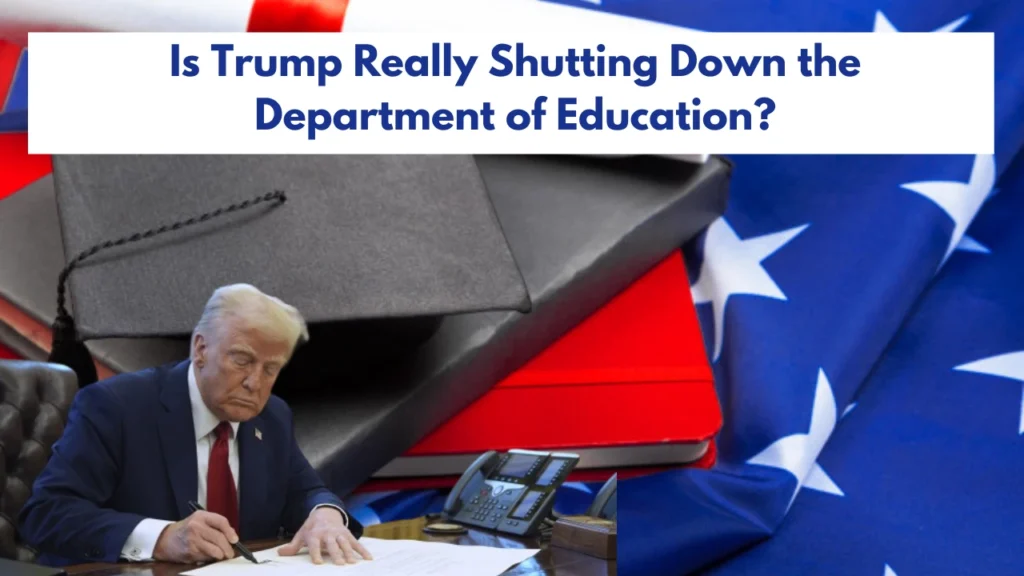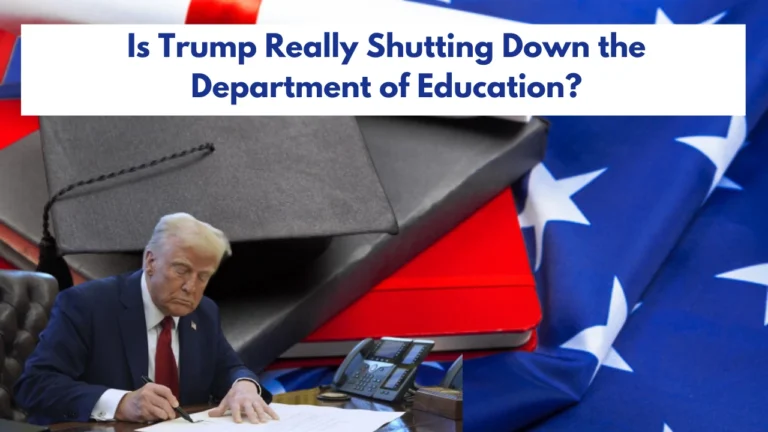Former President Donald Trump is expected to sign an executive order on Thursday destroying the U.S. Department of Education in a divisive and previously unusual action. This choice, which is a pillar of his long-standing campaign pledge, seeks to transfer power of education from the federal government to certain states.
Although formal agency closure calls for Congressional approval, Trump’s government is already moving to assign tasks to local governments. The action caused quick legal challenges from Democratic state attorneys general suing to stop the closure and stop the layoffs of about half of the department’s staff members.
Proponents contend that this approach will streamline bureaucracy, empower states, and increase the efficiency of public education; detractors warn that it may compromise funding for public schools, erode civil rights safeguards, and deepen educational disparity.
This paper examines the reasons for Trump’s policy push, the possible outcomes, and the main political and legal obstacles still to come.

Trump’s Plan to Shut Down the Department of Education
| Key Aspect | Details |
|---|---|
| What Happened? | Trump will sign an executive order directing the closure of the Department of Education. |
| Reason for Closure | To decentralize education policies and transfer control to state governments. |
| Legal Requirement | The formal shutdown of the department requires Congressional approval. |
| Implementation Strategy | Even without full closure, Trump can restrict operations and limit federal oversight. |
| Lawsuit Against the Order | Democratic state attorneys general have filed lawsuits to block the move and stop staff layoffs. |
| Impact on Education System | Shifts control to states, raising concerns over funding, civil rights, and school policies. |
| Education Secretary’s Role | Linda McMahon has been directed to ensure a smooth transition while maintaining services. |
| Historical Context | The Department of Education was established in 1979 under President Jimmy Carter. |
| Challenges Ahead | Congressional resistance, lawsuits, and uncertainty over student loans and public school funding. |
Trump’s aggressive push to dismantle the Department of Education is set to shape the future of American schooling. While supporters celebrate local control, opponents warn of significant disruptions that could affect students, educators, and policymakers for years to come.
Why Was the U.S. Department of Education Established?
The U.S. Department of Education (ED), a cabinet-level agency, oversees education policy, funding programs, and equity initiatives. Established in 1980, it supports state and local education systems, administers grants and loans, enforces civil rights laws, and conducts research to improve educational outcomes.
Why Does Trump Want to Eliminate the Department of Education?
Former President Donald Trump aims to eliminate the U.S. Department of Education to decentralize power, improve financial efficiency, promote school choice, and reduce federal oversight. Supporters argue this will empower states, while critics warn it may harm funding, civil rights protections, and public school quality.
Reasons Behind the Move
| Reason | Details |
|---|---|
| Decentralization of Power | Shifts education control to states, allowing local governments to set curricula, testing standards, and teacher policies. |
| Financial Efficiency | Trump argues that federal spending on education has failed to improve outcomes. Eliminating the department could reduce bureaucracy and reallocate funds more efficiently. |
| Promoting School Choice | Encourages vouchers for private and charter schools, giving parents more control over their children’s education. |
| Reducing Federal Oversight | Supporters believe federal regulations hinder innovation and create unnecessary bureaucracy in education policy. |
| Legal Challenges | Attorneys general from 20 states have sued, arguing that dismantling the DOE violates the U.S. Constitution and weakens federal protections. |
| Impact on Student Loans | DOE oversees $1.6 trillion in student loans. Critics warn eliminating it could disrupt financial aid and loan services. |
| Job Cuts & Downsizing | Trump’s plan includes laying off over 1,300 DOE employees, reducing the agency’s workforce by almost 50%. |
While supporters see this move as a way to increase efficiency and state control, critics argue it may worsen inequality, weaken public education, and disrupt federal funding. The final decision depends on Congressional approval and potential legal battles ahead.
Expert Opinions on Trump’s Plan
Education policy, funding programs, student loans, and civil rights enforcement are all regulated by the U.S. Department of Education (ED). Supporting state and local education systems, it conducts research to enhance outcomes and was established in 1980. Critics warn that the removal of the DOE could undermine funding, impair civil rights protections, and disrupt financial aid programs, making it a highly debated issue. However, supporters of Trump’s plan contend that it will reduce bureaucracy and provide states with more control.
Supporters’ View
Dr. Linda McMahon, former head of the Small Business Administration, supports the plan, saying it gives parents more control over education and reduces unnecessary spending.
“Returning education to local communities empowers parents and eliminates wasteful federal spending.”
The White House argues that federal control has failed students and spent $3 trillion since 1979 with little improvement in outcomes. Trump calls the DOE “a big con job.”
Opponents’ View
Randi Weingarten opposes the move, calling it a threat to public schools and the millions of children who depend on federal programs.
“Eliminating the Department of Education is a direct attack on public schools and millions of children who rely on federal programs.”
Critics warn that shutting down the DOE could disrupt billions in school funding, weaken civil rights protections, and affect student loans.
Legal Challenges and Impact of the DOE Shutdown
Trump’s plan to eliminate the Department of Education (DOE) has sparked legal battles and concerns over its impact. Attorneys general from 20 states and Washington D.C. have filed lawsuits, arguing that massive job cuts will prevent the department from carrying out its core functions. Additionally, since Congressional approval is required to eliminate a federal agency, legal challenges are expected. If implemented, the shutdown could lead to major disruptions in school funding, student loans, and civil rights protections for disadvantaged students.
| Category | Key Issues |
|---|---|
| Lawsuits Filed | 20 states + Washington D.C. sued to block the DOE shutdown. |
| Legal Requirement | Congress must approve eliminating a federal agency, making legal battles likely. |
| Job Cuts | Over 1,300 DOE employees to be laid off, reducing staff from 4,133 to 2,183. |
| Funding Disruptions | Billions in federal aid for K-12 schools, student loans, and special education at risk. |
| Civil Rights Concerns | Oversight for disadvantaged students and children with disabilities may weaken. |
Trump’s plan faces major legal and political hurdles, and its outcome depends on Congressional approval and ongoing court battles.
Frequently Asked Questions
What is Trump’s plan for the Department of Education, can he close it without Congress, and why?
Trump plans to eliminate the Department of Education through an executive order, transferring control to state governments. However, Congress must approve the formal shutdown, making legal challenges likely. He argues that federal oversight has failed and that states should have full control over education policies for better efficiency.
Why does Trump want to eliminate the Department of Education, and what are the concerns?
Trump aims to shift education control to states, cut federal bureaucracy, promote school choice, and reduce regulations. Critics warn it could disrupt student loans, weaken federal protections, and lead to major job cuts. 20 states have sued, arguing the move violates the U.S. Constitution.
What does the U.S. Department of Education do, and why is its elimination controversial?
The U.S. Department of Education (ED) oversees education policy, funding programs, student loans, and civil rights enforcement. Established in 1980, it supports state and local education systems and conducts research to improve outcomes. Supporters of Trump’s plan argue that eliminating the DOE will reduce bureaucracy and give states more control, while critics warn it could undermine funding, weaken civil rights protections, and disrupt financial aid programs, making its removal a highly debated issue.

